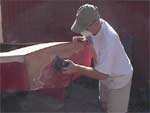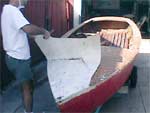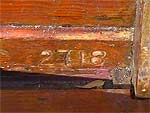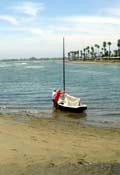Launching Fearless
by Shawn
Payment
It was the best of times,
it was the worst of times… but at even at its worst, it
was still pretty darn good!
On Saturday, May 15, I awoke
to a crystal blue sky and barely the slightest hint of movement
in the air here in San Diego, California. I said a silent prayer
to the gods of wind and asked them for a brief exhalation—a
10-15 knot breeze if you please. By noon, my wish had been granted.
The flag at Mission Bay’s De Anza cove was fluttering smooth
and steady. It would be a good day for Fearless the Blue Jay to
return to sea.
This was to be our shakedown
cruise. A test sail to make sure that everything was working right
before we hold an official coming out party. For over two years,
my pal Buddy Hammond and I had spent our Saturday mornings repairing,
restoring and refinishing this old hull and it was finally time
to put it to the test. It was finally time to spend a Saturday
sailing instead of working!
 Free Boat
Free Boat
(click images to enlarge) |
This adventure had begun
in February 2002, when I received an e-mail from our local messabout
group which offered a “Free Boat”. I called the phone
number out of curiosity and learned that the boat in question
was located only a couple miles from my office. I made an appointment
during the lunch hour to drop by and check it out.
When I first saw Fearless,
she was sitting under a dirty tarp in the side yard of Peter Jensen’s
Del Mar home. Peter explained that he had obtained the boat from
it’s original owner and then sailed it for many years with
his wife and children. His kids were now grown and gone however
and the boat had sat untouched for several years. Peter removed
a tattered, threadbare tarp to reveal the faded red hull covered
with bubbled paint, flaking varnish and patchy white globs of
thick spackle that had been inexpertly smeared into the ever-widening
cracks between the deck and hull. The hull had been sitting bow
down on a wooden trailer and it didn’t take long to discover
the fist-sized hole where water had pooled and then rotted right
through the bottom. It was a disaster.
But I also saw some things
that I liked. On the deck was a small but classic brass winch
and several severely tarnished brass cleats. The centerboard and
interior frames were solid mahogany. The rig was battered but
complete and Peter still had the original main sail, jib and spinnaker
all in good condition.
My first thought was that
I could strip every bit of this hardware to use on some future
boat project. Unfortunately, I didn’t have any room at home
to store or work on such a project. It was then that I remembered
a recent conversation with my friend Buddy Hammond. I had mentioned
my desire to build a larger boat but was thwarted by a lack of
adequate work space. Buddy had jokingly pointed out that his garage
was too small for his large van but more than big enough for a
boat. At the time, we responded to his suggestion with a good-natured
laugh before the conversation moved on to other things. It all
came flooding back to me now. I dialed the phone and told Buddy
that I had “a crazy idea”. I didn’t even have
to convince him. He was onboard from the start.
 Buddy Sanding
Buddy Sanding |
The weekend came and we towed
the boat down to Buddy’s house and immediately began stripping
off all the hardware.
“Do you think we can
fix it?” Buddy asked.
“Let’s just
get all the hardware off and then we’ll see where we stand,”
I replied.
By the next weekend, we were
looking at a bare hull—faded, peeling and with a big, rotten
hole in the nose.
“Do you think we can
fix it?” Buddy asked.
“Let’s just
strip the paint off and then we’ll see where we stand,”
I replied.
Over the next few months,
this process repeated itself many more times.
“Do you think we can
fix it?” Buddy asked.
“Let’s just
get the (varnish, centerboard case/deck/hull panels) off and then
we’ll see where we stand,” I replied.
 Stripping
Stripping |
The more things we took off,
the more things we found to fix. But we soldiered on. Over time,
we had also learned the history about our little boat which only
made it all the more endearing. The boat had been built in San
Diego in 1962 by a fellow named Richard Shoemaker. Shortly after
we obtained the boat, I had tracked down Richard’s wife,
Beatrice, who informed me that Richard had passed away in 1984.
Richard had been an architect.
This Blue Jay was the only boat he had ever built. Their neighbor,
Al Cohall, a former commodore at Mission Bay Yacht Club (MBYC)
had encouraged her husband to build the boat and join the club.
Cohall had also convinced another mutual friend, Mort Sherman,
to build a Blue Jay and even lent Sherman his garage to build
it in. Shoemaker and Sherman built the two Blue Jay's side-by-side
in neighboring garages. Once complete, they and their families
had sailed and raced the boats as part of MBYC’s Blue Jay
Fleet 82.
We also learned that the
Blue Jay had originally been designed by Sparkman & Stephens
in 1947. The goal was to provide a smaller version of their popular
Lightning design which would be more suitable for junior skippers.
The Blue Jay (also nicknamed "Baby Lightning") was designed
to include all the thrills of its big sister, including a spinnaker,
and was available in kit form for home construction. The design
turned out to be a success with older folk as well; in fact, the
first Blue Jay fleet in San Francisco Bay was helmed entirely
by adults.
 We were committed
We were committed |
Buddy and I were committed.
Or rather, we should have been. No obstacle was too great. No
spot of rot was too big. We epoxied parts where we could and replaced
parts that were beyond repair. We dreamed of having the boat back
in the water by the Fourth of July 2002. We didn’t even
come close.
Admittedly, we we’re
always diligent in our work. We both have jobs. We both have families.
Occasionally, it would rain. Other commitments would fill up our
schedules and whole months would go by without picking up a tool.
But it was always there, waiting for the next step. An hour here,
two hours there, always just enough progress to fuel the hope
that Fearless would sail again.
And then there was the name.
For the first forty years of its existence, the boat had apparently
remained nameless. Neither the previous owner nor the builder’s
wife had any recollection of a name. At first, we simply referred
to her by the hull number that we had found inscribed on the centerboard
case: “2718”. I felt certain that she'd tell us her
name at some point during the restoration.
 Hull number 2718
Hull number 2718 |
It was a late summer afternoon
at a messabout on San Diego Bay when it came to me. I was staring
across the bay at the Navy base and remembering my old Navy minesweeper,
MSO-442, the USS Fearless, a little wooden ship. Fearless was
decommissioned in 1990 and scrapped in 1993.
The following weekend, I
asked Buddy what he thought of the name: "Fearless".
He informed me that "Fearless" was the name of his first
cat. He liked that cat. We asked the boat what it thought of the
name. I think I heard it purr.
But now it’s two years
later and I’m backing the trailer down the launch ramp toward
Mission Bay. My trusty Mercedes sedan is no SUV so I’m a
bit timid about plunging down the launch ramp with complete abandon.
The trailer tires barely touch the water before Buddy and I decide
to lift the boat off the trailer and drop it in the water. We’re
shocked by the weight of the hull with complete rig. Still, we
manage to lift the hull and slide her into the water in sloppy,
uncoordinated fashion.
It floats.
 Rigging
Rigging
|
Buddy tends the boat over
to the beach while I park the car. We begin to set sails. The
halyards are all tangled. How did that happen? We raise the main.
Damn, forgot the battens. We lower the main, insert battens, raise
it again. Up goes the jib. Why did I put the halyard cleats so
far under the foredeck? Buddy grabs the rudder. We discover that
the rudder draws a surprising amount of water. I walk the hull
deeper. Deeper. My shorts are soaked but Buddy finally aligns
the pintles and the rudder drops into place. Time to sail.
Buddy scrambles aboard. I
give one big shove and heave myself over the port quarter and
into the cockpit. The sails sheet home and we’re off. Fearless
is back at sea!
Buddy yells at an idiot on
a jet ski who’s speeding through the No Wake zone. I tell
him to let it go and look around. We’re sailing! An easy
broad reach on starboard tack. I give the tiller a push to see
how high she’ll point. Very nice. Buddy and I are grinning
like fools.
 idiot on a jet ski
idiot on a jet ski |
I am immediately impressed
by how balanced the boat is. There’s almost no pressure
on the tiller. As we lower the centerboard to it’s full
depth, you can feel the hull grab and lift toward the wind. Then
I notice we’ve got a twist in the jib tack where I shackled
it down backwards. Buddy takes the tiller and I scoot myself out
onto the foredeck to make the change. Fearless sails on through
it all, smooth and steady.
We tack back toward our starting
point as my wife Susan takes pictures. I’ll find out later
that she can’t figure out how to work the zoom so all the
shots are tiny and far away. Oh well, there will be other days
for glamour shots.
Another tack and we’re
heading back out across the bay. We’re still grinning. We
sail along for another ten minutes before I decide that the jib
halyard needs adjustment. I duck my head down to the cleat under
the foredeck. Suddenly, I feel the hull turning up sharply into
the wind.
“What are you doing?”
I shout to Bud.
Buddy is craning his neck
to look over the transom.
“Rudder broke”
he says in response.
“What do you mean
‘the rudder broke’?” I say.
“I mean ‘the
rudder broke’” he responds.
 "the rudder broke"
"the rudder broke" |
With this exercise in eloquence
behind us, I scramble aft and see a large crack bisecting the
rudder blade. The bottom portion of the blade is flapping independently
of the tiller. I look up and sight our launching point about a
quarter mile away downwind and search my memory for childhood
sailing lessons when I learned to sail without a rudder. I simultaneously
discover that I can reach down and grab the aft edge of what remains
of our rudder.
We fall off, loosen the sails
and the bow neatly sets itself on a course for home. Once again,
I note with pleasure the natural balance of the rig. Although
I can’t make any dramatic course changes, there’s
so little pressure on the rudder that I have little difficult
simply holding it dead astern to maintain a steady course. Minutes
later, we pull ashore at our original launching point. As we enter
shallow water, the broken rudder touches bottom, pops out of its
mounts and floats toward the beach on its own.
“Is that supposed to
happen?” Susan calls from shore.
We scramble out of the boat,
gather in the wayward rudder and begin to unrig. I look at Buddy.
He’s still smiling.
“What do you mean ‘the
rudder broke’?” he parrots at me with a mocking grin.
I can’t help but laugh.
It was the best of times, it was the worst of times. I spent the
rest of the weekend telling anyone who would listen:
“She was sailing sooooo
nice… until the rudder broke.” And even then she still
sailed nice, I think to myself.
And she’ll sail again.
Soon.


|

